

Maarten Steurbaut - Rubik's magic Cube. (design: August 2003) (Due to limited webspace (50Mb), images have been reduced in size.
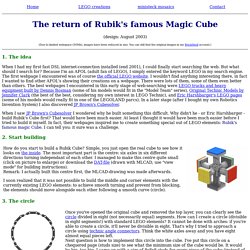
You can still find the original images in my BrickShelf account.) 1. The idea When I had my first fast DSL internet-connection installed (end 2001), I could finally start searching the web. When I saw JP Brown's Cubesolver I wondered why he built something this difficult. 2. 3. 4. At this point I knew my cube was going to be very big. Chondroitinase ABC Digestion of the Perineuronal Net Promotes Functional Collateral Sprouting in the Cuneate Nucleus after Cervical Spinal Cord Injury. We investigated whether chABC applied to the partially denervated adult rat cuneate nucleus reduced inhibition by CSPGs in the perineuronal net and promoted sprouting of the remaining forelimb primary afferents.
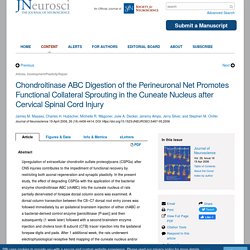
Here we report that chABC, but not P-ase, treatment effectively (1) reduced CSPGs within and surrounding the parenchyma of the cuneate nucleus, (2) resulted in a significantly increased area within nucleus cuneatus that was occupied by the remaining forepaw primary afferents, and (3) produced a significantly increased number of neurons within the cuneate nucleus that responded physiologically to the remaining afferents. We conclude from these results that reducing CSPG-mediated inhibition within the cuneate nucleus markedly enhances functional sprouting by spared primary afferents after cervical spinal cord dorsal column injury. Very long-term memories may be stored in the pattern of holes in the perineuronal net. Roger Y.
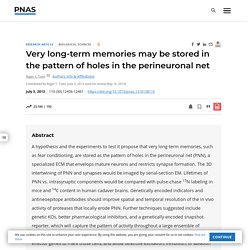
Tsien1 Author Affiliations Contributed by Roger Y. Tsien, June 3, 2013 (sent for review May 16, 2013) Abstract A hypothesis and the experiments to test it propose that very long-term memories, such as fear conditioning, are stored as the pattern of holes in the perineuronal net (PNN), a specialized ECM that envelops mature neurons and restricts synapse formation. Box 2 : Synaptic plasticity, memory and the hippocampus: a neural network approach to causality : Nature Reviews Neuroscience.
Memory has many forms and is distributed across many brain regions.
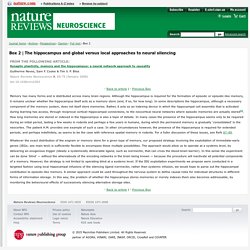
Although the hippocampus is required for the formation of episodic or episodic-like memory, it remains unclear whether the hippocampus itself acts as a memory store (and, if so, for how long). In some descriptions the hippocampus, although a necessary component of the memory system, does not itself store memories. Rather, it acts as an indexing device in which the hippocampal cell assembly that is activated during learning has access, through reciprocal cortical–hippocampal connections, to the neocortical neural networks where episodic memories are actually stored86.
Parietal Lobe and Episodic Memory: Bilateral Damage Causes Impaired Free Recall of Autobiographical Memory. Marian E.

Berryhill1,2, Lisa Phuong1, Lauren Picasso1, Roberto Cabeza3, and Ingrid R. Olson1,2 +Show Affiliations Correspondence should be addressed to Marian E. Berryhill, Center for Cognitive Neuroscience, University of Pennsylvania, 3810 Walnut Street, Philadelphia, PA 19104-6196. berryhil@psych.upenn.edu The Journal of Neuroscience, 26 December 2007, 27(52): 14415-14423; doi: 10.1523/JNEUROSCI.4163-07.2007.
Mechanism of long-term memory identified. Using advanced imaging technology, scientists from the Florida campus of The Scripps Research Institute have identified a change in chemical influx into a specific set of neurons in the common fruit fly that is fundamental to long-term memory.
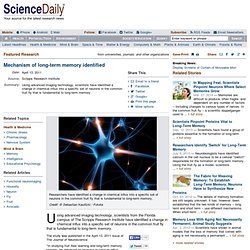
The study was published in the April 13, 2011 issue of The Journal of Neuroscience. The fabric for weaving memory: To establish long-term memory, neurons have to synthesize new proteins. The details of memory formation are still largely unknown.

It has, however, been established that the two kinds of memory -- long term and short term -- use different mechanisms. Motor memory: The long and short of it. For the first time, scientists at USC have unlocked a mechanism behind the way short- and long-term motor memory work together and compete against one another.
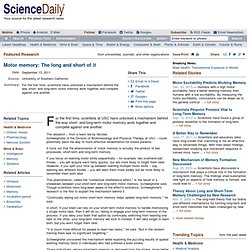
The research -- from a team led by Nicolas Schweighofer of the Division of Biokinesiology and Physical Therapy at USC -- could potentially pave the way to more effective rehabilitation for stroke patients. It turns out that the phenomenon of motor memory is actually the product of two processes: short-term and long-term memory. If you focus on learning motor skills sequentially -- for example, two overhand ball throws -- you will acquire each fairly quickly, but are more likely to forget them later. However, if you split your time up between learning multiple motor skills -- say, learning two different throws -- you will learn them more slowly but be more likely to remember them both later.
Researchers identify 'switch' for long-term memory. Neurobiologists at Heidelberg University have identified calcium in the cell nucleus to be a cellular "switch" responsible for the formation of long-term memory.

Using the fruit fly Drosophila melanogaster as a model, the team led by Prof. Dr. Christoph Schuster and Prof. Dr. Researchers See What Memory Looks Like in Brain. Biologists led by Dr Don Arnold and Dr Richard Roberts from the University of Southern California, Los Angeles, have released an astonishing picture of memories forming inside the mouse brain.

This image shows a living neuron in culture: green dots indicate excitatory synapses; red dots indicate inhibitory synapses (Don Arnold) The researchers engineered microscopic probes that light up synapses in a living neuron in real time by attaching fluorescent markers onto synaptic proteins. The fluorescent markers allow them to see live excitatory and inhibitory synapses for the first time and, importantly, how they change as new memories are formed. Long-Term Retention Explained by a Model of Short-Term Learning in the Adaptive Control of Reaching. Fear: Replacing Memories. January 04, 2010 The human brain goes through a complex process to form and consolidate memories.
But is it possible to replace memories of fearful events, and in doing so, assist in the treatment of patients suffering from the debilitating effects of post-traumatic stress disorder or other anxiety disorders? Dr.Joseph LeDoux and a team of New York University neuroscientists think they have found a way to replace traumatic memories through therapy. Download this video. Watch on YouTube. Amnesia - Types. There are six different types of amnesia depending on the causes and the nature of disease progression. a) Anterograde amnesia Anterograde amnesia happens as a result of brain trauma that involves the hippocampus, fornix, or mammillary bodies.
Here the patient is unable to recollect events, that occur after the onset of the amnesia, for more than a few minutes. In other words, in these patients, recent events are not transferred to long-term memory. For example the patient is unable to recollect what his colleague’s name is or what he had for breakfast or which movie he saw the day before.
Although the person''s intelligence, personality and judgment is intact he may have trouble in retaining his job because his day- to- day functional memory is poor. Johns Hopkins Memory Disorders Center. Forgetfulness — 7 types of normal memory problems. It's normal to forget things from time to time, and it's normal to become somewhat more forgetful as you age. But how much forgetfulness is too much? How can you tell whether your memory lapses are within the scope of normal aging or are a symptom of something more serious? Healthy people can experience memory loss or memory distortion at any age. Some of these memory flaws become more pronounced with age, but — unless they are extreme and persistent — they are not considered indicators of Alzheimer's or other memory-impairing illnesses.
Seven normal memory problems 1. This is the tendency to forget facts or events over time. 2. This type of forgetting occurs when you don't pay close enough attention. 3. Someone asks you a question and the answer is right on the tip of your tongue — you know that you know it, but you just can't think of it. 4. Misattribution occurs when you remember something accurately in part, but misattribute some detail, like the time, place, or person involved. THE BRAIN FROM TOP TO BOTTOM. In retrograde amnesia, patients forget events that occurred in their lives before they experienced the trauma, and the oldest facts are the ones least likely to be forgotten. Recovery is possible, but the events that occurred closest to the time of the accident are harder to retrieve and may be lost forever. . Typically, the patient remembers words and general knowledge, such as who their country’s leader is. Retrograde amnesia is often associated with neurodegenerative pathologies such as senile dementia and Alzheimer’s disease.
Discovering the source of long-term motor memory. The motor memory we use everyday-for sport, playing a musical instrument and even typing-is acquired through repeated practice and stored in the brain. New motor skills can be learned through practice, but often those skills can be all but lost by the following day. Parts of the Brain - Memory & the Brain.